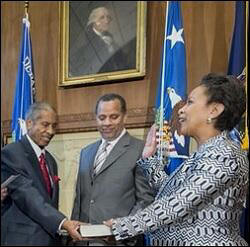Courtesy of Pam Martens.
Loretta Lynch Is Sworn In on Monday, April 27, 2015 as U.S. Attorney General; She’ll Now Be Responsible for the Flash Crash Case
The Justice Department’s case against the 36 year old lone bedroom trader in the U.K., Navinder Singh Sarao, has now been thoroughly discredited by every Wall Street veteran who has studied it, most pointing out that what Sarao did is happening every second that Wall Street is open for business. Business writers at the New York Times, Financial Times, Newsweek, and Bloomberg View have given the charges an unequivocal thumbs down.
The Justice Department’s complaint itself is unusual. It consists of a one page complaint cover sheet followed not by a detailed breakdown of the counts but by an affidavit from an FBI agent. The case is filed in the Federal District Court in the Northern District of Illinois but no U.S. Attorney or Assistant U.S. Attorney from that district has signed this complaint. The names listed at the top of the first page, more as a reference since they have not signed any part of this complaint, are Department of Justice Fraud Section Assistant Chief Brent S. Wible and Fraud Section Trial Attorney Michael T. O’Neill. Both show phone numbers with the 202 area code, meaning this case came out of the Washington, D.C. office of the Justice Department, not the Northern District of Illinois where the futures market that Sarao is charged with manipulating is located.
The case is based largely on analysis from an unnamed “consulting group” and a “professor and academic researcher who studies and has written extensively on financial markets and algorithmic trading.” Given the public drubbing of this case, that professor is now likely climbing deeper into his hole of anonymity.
Add all of the above to the fact that the case is coming out of the blue, five long years after the Flash Crash of May 6, 2010, and after regulators had already fingered mutual fund company Waddell & Reed as the key culprit in their lengthy report of 2010, and you are left with the highly intriguing question as to what the real motivation is for the Justice Department to go out on such a precarious limb with this case.
Four schools of thought come readily to mind. First is that the Justice Department wants to frighten off the tens of thousands of solo day traders who are jazzing up pre-packaged software and periodically beating the Wall Street big boys at their own game of spoofing and layering. Next is that Sarao may be some kind of genius trader or software developer and Wall Street wants him extradited to deploy his talents on this side of the pond. Third, there may be more to the FBI’s case than we know: for example, why was a mega global bank like Credit Suisse financing Sarao’s trading. Was there more to this relationship than is presently known? And, finally, elements of all three of the above scenarios may be in play. We’ll look at each of the first three elements separately.
…




